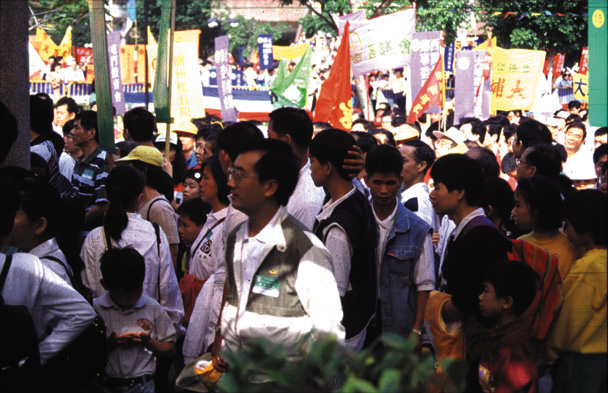 Fund
raising
Fund
raisingPocket change can make a big difference to local charities



 Fund
raising
Fund
raising
Pocket change can make a big difference to
local charities
By Apple Fu
Flag selling — the practise of selling stickers around railway stations — is a common method to raise money. However, as a result of an increase in applications for flag days, which are regulated by the Government, some charity groups have to sell flags on weekdays.
Also, charity organizations launch gala dinners every year. For example, in October 1995, more than 420 guests gathered at the Grand Hyatt Hong Kong’s ballroom for Operation Smile China Medical Mission. The organizing committee raised about $3.7 million.
However, the amount of money collected is far from enough to help those in need.
Thus, more activities are needed. Innovation seems to be the most powerful strategy to raise funds. Apart from traditional gala dinners and flag days, new fund-raising activities are being invented to raise people’s concerns.
Dress Casual Day is one of the more creative methods, It has gained wide support from the public. Miss Wendy Tso, the community relations manager of Community Chest, said that last year about $1 million was collected on Dress Casual Day.
Instant raffle tickets are on sale at nearly 1,000 outlets each year. These scratch-and-win tickets at $10 each offer double winning opportunities, with redeemable prizes and a lucky draw.
Besides, from 18 to 22 December 1995, the organization and the Staggered Working Hour Committee jointly organized a programme called “Staggered Hours Week 95”.
A total of 100,000 stored value tickets were distributed. Holders could take City Bus, ferries, the Kowloon Canton Railway, the Mass Transit Railway, the Light Transit Railway, Kowloon Motor Bus and trams in specified working hours without paying any fees.
The emergence of these new strategies to attract public attention is due to a drop in donations from the business sector.
Miss Nancy Yu, the senior manager of the community relations of the Community Chest, said funds from the business sectors were falling.

To encourage more donations, companies donating a certain amount of money receive awards.
“However, the number of award winners dropped from 359 in 1994 to 353 in 1995,” she said. “Among the winners, those who
donated between $338,000 and $668,000 decreased from 26 last year to this year’s 17.”
 Above: Public support is a must for success of charitable activities.
Above: Public support is a must for success of charitable activities.
According to the Community Chest’s annual reports of the past five years, businessmen were the main contributors.
Miss Yu said that the drop in their donations resulted in a shift of target to the general public.
The Community Chest has successfully gained the cooperation of many private corporations to help launch its programmes.
Each year, the Community Chest carries out an “Employee Contribution Programme” which is supported by Hongkong and Shanghai Bank.
The staff of the bank take part in fund raising events like Walks For Millions and Dress Casual Day. They not only donate money, but also commit their time through volunteer programmes.
“Your Future Is Our Future” is the slogan the organization advocates to arouse public awareness towards those in need.
Funds can also been raised through mass media.
Another charity organization, Po Leung Kuk, cooperates with Television Broadcast Limited to organize a fund-raising show every year. Last year, $5 million was raised.
The public relations manager of Po Leung Kuk, Miss Kitty Yam, said, “The media are effective in attracting audiences — especially media that can invite pop stars, who gain wide support from their fans.”
Commercial corporations — McDonald’s, Hongkong and Shanghai Bank, Hongkong Telecom, the Royal Hong Kong Jockey Club and the International Bank of Asia — also take the initiative to support local charities.
Fund-raising activities thus have become more diversified. For example, charity phone cards and visa cards are provided for some donors.
The public seem to have positive attitude towards the creative programmes.
Miss Kwok Ying Ling of Yuen Long expressed her appreciation towards the effort that charity organizations made. Yet, she added, “They should promote these programmes more widely since some of them are unheard of.”
Despite all the inadequacies and difficulties, Miss Wendy Tso of the Community Chest said that it is grateful that many organizations help them to tackle problems. For example, the Education Department encourages students as sources of volunteers. Also, commercial groups are willing to sponsor costs of the campaigns.

